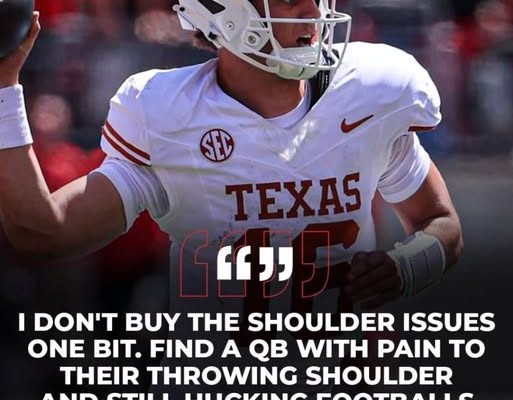Arch Manning’s rise at Texas has been one of the most closely watched storylines in college football, and it has also been one of the most heavily scrutinized. Every throw, every decision, and even his body language on the field is analyzed as if it were a preview of his long-term career. When Arch steps onto the field, he is not just carrying the weight of being a quarterback at Texas; he is carrying the Manning legacy, which has spanned multiple generations of elite quarterback play. With all of that attention, it is no surprise that every minor stumble or speculation about his health becomes a talking point. But one truth has become increasingly clear to those watching closely: Arch Manning would not be playing like he is if he was hurt, and the results we’ve seen this season are a testament to both his physical readiness and his mental resilience.
There’s a long history in sports of rumors surfacing whenever a star player has an off night. If a quarterback struggles, fans often wonder if there’s an undisclosed injury holding him back. For Arch, those whispers became louder early in the season after a couple of performances where he seemed less explosive or slightly off rhythm. With the spotlight magnified, people quickly jumped to conclusions. Yet his play in the weeks that followed told a different story. His ability to step up in the pocket, extend plays with his legs, and make difficult throws under pressure are not the traits of a quarterback nursing a significant injury. Quarterbacks who are hurt usually show it in subtle ways: hesitating to run, avoiding contact, shortening their throwing motion, or missing on deep passes they’d normally make. None of those patterns have been consistently present in Arch’s recent games. Instead, he has looked sharper, more confident, and more capable of carrying the Texas offense than at any earlier point in his career.
The physical demands of playing quarterback at a major program like Texas are immense, especially with the level of competition in the Big 12 and beyond. Arch has been tested not just by defenses trying to confuse him with coverages, but also by the physicality of blitzing linebackers and defensive linemen collapsing the pocket. An injured quarterback usually falters under that type of pressure, often choosing to throw the ball away quickly or settling for check-downs rather than pushing the ball downfield. Arch, however, has been doing the opposite. He’s taking shots downfield, threading passes into tight windows, and showing confidence in his arm strength. Those decisions require not only mental conviction but also trust in one’s physical health. It’s nearly impossible for a quarterback to play at that level if his body isn’t cooperating.
Another clear sign that Arch is fully healthy comes from the way Texas has structured its offense around him. Coaches are not hesitant to let him run designed plays that put his body on the line. When an athlete is dealing with an injury, especially to something like the shoulder, ribs, or lower body, coaches typically adjust the game plan to minimize the risk of aggravating it. They’ll keep their quarterback in the pocket, limit designed runs, and reduce the number of deep passes. That hasn’t been the case with Arch. The Texas coaching staff has given him the freedom to fully command the offense, mixing in deep shots, rollouts, and even the occasional quarterback draw. That level of trust from his coaches is the strongest endorsement that he is physically able to handle the responsibilities of a dual-threat quarterback.
Beyond the X’s and O’s, Arch’s demeanor on the field also reveals a lot about his health. Quarterbacks who are hurt often carry themselves differently. They may grimace after a hit, adjust their pads constantly, or show hesitation when getting back up after a tackle. In Arch’s case, he has been nothing but composed and collected. His confidence seems to grow with each series, and that comes from knowing he can rely on his body. Players don’t smile or celebrate after taking a hit unless they feel comfortable. Arch has not only been celebrating with his teammates but has also shown leadership by encouraging the offensive line and motivating receivers after every drive. That doesn’t look like someone who is simply pushing through pain.
Of course, part of the speculation about Arch’s health comes from the pressure of expectations. The Manning name alone brings with it constant comparisons to Peyton and Eli, both of whom dealt with their own injury challenges throughout their careers. Fans may assume that Arch, like his uncles, will face similar setbacks, and they may be quick to attribute any inconsistency to a hidden injury. But the truth is, inconsistency is part of the natural development of a young quarterback. Arch is still learning to read defenses at the highest level, still adjusting to the speed of college football, and still developing his chemistry with receivers. Struggles don’t always need an injury explanation; they can simply be growing pains.
One of the most telling aspects of Arch’s current level of play is the way defenses are respecting him. Teams are no longer simply loading the box to stop the Texas run game. Instead, they are dropping safeties back, disguising coverage, and throwing complex defensive schemes at him. That’s the type of attention reserved for quarterbacks who have proven they can hurt you through the air. If Arch were truly battling a physical issue, defenses would likely sense it and bring more pressure, daring him to make throws. The fact that defenses are adjusting to him shows that opponents recognize his ability to execute at a high level.
There’s also the matter of statistics. Numbers don’t always tell the whole story, but in Arch’s case, they support the argument that he is fully capable physically. His passing efficiency has gone up, his touchdown-to-interception ratio has improved, and his rushing numbers suggest he’s not afraid to use his legs. Injured quarterbacks don’t put up those kinds of numbers over a sustained stretch. They may have one good game fueled by adrenaline, but the consistency Arch has displayed indicates durability and health.
At the heart of this discussion is a broader truth about athletes and perception. When a star player has an off day, people often assume there must be something physically wrong. But in reality, even the best quarterbacks in the world have games where they look out of sync. Patrick Mahomes, Tom Brady, and Joe Burrow have all had stretches where they didn’t look like themselves. For Arch Manning, those occasional dips in performance shouldn’t automatically spark injury rumors. Instead, they should be viewed as part of his growth process, especially as a young player adjusting to the weight of enormous expectations.
The resilience Arch has shown speaks volumes about his character. He could easily allow the noise around his health and performance to distract him, but instead, he’s focused on winning games and improving each week. That mental toughness is just as important as his physical health. A quarterback’s confidence can collapse if he starts believing he’s hurt or incapable, but Arch has maintained a level head, which is why his progression looks so promising.
Texas fans should take comfort in the fact that their quarterback is playing with poise, strength, and confidence. If Arch Manning were battling a serious injury, it would be evident not only in his play but also in the way the coaching staff and teammates responded to him. The reality is that he is delivering on the hype, proving he can handle the pressure, and showing flashes of the greatness that has long been predicted for him. Injuries are always a concern in football, but for now, the evidence overwhelmingly points to a healthy quarterback who is steadily growing into the leader Texas hoped he would become.
The narrative that Arch Manning might not be fully healthy is one that fuels speculation but doesn’t hold up under scrutiny. His ability to make difficult throws, absorb hits, lead the offense with confidence, and show steady improvement all point to a player who is physically ready for the moment. The truth is simple: Arch Manning would not be playing like he is if he was hurt. The young quarterback is proving not just that he belongs on the field, but that he has the potential to elevate Texas football to levels it hasn’t reached in years. His health, his resilience, and his steady progression are combining to create a story that is only just beginning, and if these early performances are any indication, Texas fans and college football as a whole are witnessing the rise of a star who is just getting started.



